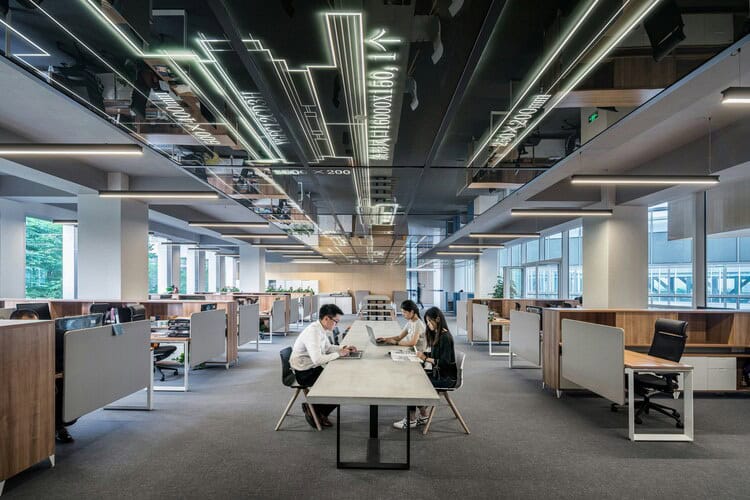As the business world adjusts to the realities of climate change, the concept of sustainable office construction has gained significant traction. Today, forward-thinking companies are working to create spaces that are not only environmentally friendly but also promote the well-being of their employees.
Among these businesses, sustainability is the name of the game.
Construction companies like Asa Carlton are innovating and implementing new ways to reduce the environmental footprint of their building practices; and the demand for sustainable office buildings from the companies they serve has surged, leading to a transformation in how office spaces are constructed and designed.
This blog will explore the critical aspects of sustainable office construction, including the benefits, techniques, and principles that make it a compelling choice for businesses today.
What makes an office building sustainable?
Sustainable office buildings provide built spaces that minimize environmental impact and maximize the positive effects on the well-being of employees.
Let’s explore some of the key factors that make an office building sustainable:
Energy Efficiency and Reduced Operational Costs
One of the key principles of sustainable office construction is energy efficiency.
Office buildings can reduce energy consumption through various techniques such as efficient insulation, LED lighting, and smart energy management systems.
By minimizing energy usage, sustainable office buildings significantly reduce operational costs, allowing businesses to save money in the long term while also reducing their carbon footprint.
Use of Eco-friendly Materials and Renewable Energy Sources
Sustainable office construction emphasizes using eco-friendly, responsibly sourced materials that reduce environmental impacts such as greenhouse gas emissions and CO2 emissions. These materials include recycled content, low-VOC paints, and sustainably harvested wood.
Additionally, renewable energy sources such as solar panels and wind turbines can be integrated into a building’s design to generate clean and sustainable energy, further reducing dependence on fossil fuels.
Indoor Air Quality and Employee Well-being
The quality of indoor air has a significant impact on employee health, productivity, and overall well-being.
Sustainable office construction focuses on indoor air quality by using materials that do not emit harmful pollutants and installing efficient ventilation systems that ensure proper air circulation.
These elements contribute to improved productivity and reduced sick leave by providing employees with a healthy and safe work environment.
Natural Light and Productivity
Sustainable office buildings maximize natural light, which not only reduces the need for artificial lighting (thereby cutting down on energy costs) but also enhances the overall work environment.
Research has shown that employees who work in environments where they are exposed to natural light have elevated moods and increased energy levels and productivity.
Implementing sustainable office construction elements, such as large windows, skylights, and light reflectors, creates bright, vibrant, and inviting spaces.
How do you build a sustainable office building?
Building a sustainable office requires thoughtful, forward-thinking planning and implementation.
Some of the key steps involved in constructing a sustainable office building are as follows:
Sustainable Office Design and Energy Efficiency
The design phase plays a crucial role in ensuring energy efficiency and environmental sustainability in your new office building.
This involves using passive design strategies, such as orienting the building to maximize natural light and airflow, and integrating energy-efficient appliances and systems.
By utilizing building information modeling (BIM) software, architects can optimize a building’s design for energy efficiency and reduce its environmental impact.
Efficient HVAC Systems and Reduced Energy Consumption
Heating, ventilation, and air conditioning (HVAC) systems contribute significantly to energy consumption in office buildings.
Companies that install high-efficiency HVAC systems that use minimal energy while providing optimal comfort can experience substantial savings on utility costs.
Additionally, smart controls and automated systems can regulate temperature and airflow, reducing energy waste.
Waste Reduction and Recycling Programs
Sustainable office construction also involves implementing waste reduction and recycling programs.
By employing proper waste management systems, businesses can divert significant waste from landfills. Tactics can include utilizing materials with recycled content, recycling, and composting.
Furthermore, sustainable office buildings can utilize water-saving features, such as low-flow fixtures and efficient irrigation systems, to minimize water consumption.
The Impact of Sustainable Offices
Sustainable office construction has far-reaching positive impacts, for both businesses and the environment.
Here are some of the significant benefits of sustainable offices:
Reduced Carbon Footprint
Sustainable offices significantly lower their carbon footprint and environmental impact by minimizing energy consumption, utilizing renewable energy sources, and reducing waste.
These practices contribute to global efforts to mitigate climate change and preserve natural resources for future generations.
Improved Employee Well-being and Productivity
Companies who utilize sustainable offices prioritize employee well-being through improved air quality, ample natural light, and comfortable workspaces. These factors enhance productivity, reduce absenteeism, and foster a healthy and motivated workforce.
Real Estate Value and Marketability
Investing in sustainable office construction is an ethical choice and a smart business decision.
Sustainable buildings have higher market demand and often command higher rental rates. More and more, potential tenants are seeking environmentally responsible spaces, and sustainable office buildings offer a competitive advantage in the real estate market.
Learn more about Asa Carlton’s expertise in corporate and office construction.
Conclusion
Sustainable office construction is the future of indoor workspaces. By focusing on air quality, natural light, energy efficiency, and the use of eco-friendly materials, businesses can create offices that benefit the environment, prioritize employee well-being, and reduce operational costs.
At Asa Carlton, we understand the importance of sustainable office construction and offer expertise in constructing sustainable office buildings that align with your business goals.
Ready to start your journey toward building a greener and more productive workspace? Contact us today to request a quote!
Remember, sustainable office construction paves the way for a greener and brighter tomorrow!










